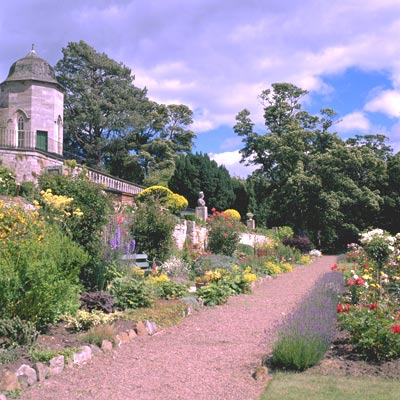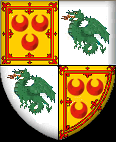|
|
The Traditions and
Stories of the House of Seton |
|

 According
to tradition, it was customary for the Earls of Wintoun once a
year to ‘ride the marches’ of their estates, which were so
extensive that a whole day, from sunrise to sunset, was required
to ride in state round the boundaries of their lands. On these
occasions the head of the house was always accompanied by a large
retinue of friends and retainers, mounted on gaily caparisoned
horses, the charger of the chief being arrayed in cloth of silk
adorned with gold tassels. The festivities which followed this
ceremonial lasted several days. According
to tradition, it was customary for the Earls of Wintoun once a
year to ‘ride the marches’ of their estates, which were so
extensive that a whole day, from sunrise to sunset, was required
to ride in state round the boundaries of their lands. On these
occasions the head of the house was always accompanied by a large
retinue of friends and retainers, mounted on gaily caparisoned
horses, the charger of the chief being arrayed in cloth of silk
adorned with gold tassels. The festivities which followed this
ceremonial lasted several days.
Seton Palace was a favourite resort of
Queen Mary. It was visited often by her in her royal progresses.
It was her first halting-place when she and Darnley made their
escape from Holyrood after the murder of Rizzio. She was
entertained there by Lord Seton in 1567, and on that occasion she
and Bothwell won a match in shooting at the butts against Lords
Seton and Huntly. The forfeit was a dinner, which the losers had
to provide in an inn at Tranent. When James VI. revisited his
native country in 1617, he spent his second night in Scotland at
Seton. Charles I. also, on his journey from London to Edinburgh,
in 1633, in order to be crowned there as well as in England,
halted a night at Seton, and was magnificently entertained by
George, third Earl of Wintoun. The castle was held for a short
time in 1715 by Brigadier Macintosh and a detachment of
Highlanders before their march to the Borders to join the
Northumbrian insurgents under Mr. Forster and Lord Derwentwater.
The fine old castle or palace of
Seton, as it was called, owing to its having been frequently the
residence of royalty occupied a commanding position on the coast
of the Firth of Forth, closely adjoining the battlefield of
Prestonpans. The date of its erection is unknown, but it had
undergone at various times considerable alterations and
enlargements. The building consisted of three extensive fronts of
freestone, with a triangular court in the middle. The front to the
south-east—which appears to have been built early in the reign of
Queen Mary—contained, beside other apartments, a noble hall and
drawing-room. The state apartments, which were very spacious,
consisted of three great rooms forty feet high, and their
furniture was covered with crimson velvet laced with gold. There
were also two large galleries filled with pictures. Altogether,
the mansion was regarded as the most magnificent and elegantly
furnished house in Scotland. | |
 |
 |
Sir Alexander Seton
Viscount Kingston

Sir Christopher Seton

Sir Christopher Seton

Sir Alexander Seton

The 7th Lord Seton in Flanders
Bailie David Seton of Tranent
Lothian
Seton's and the Post-Robbing Story
|